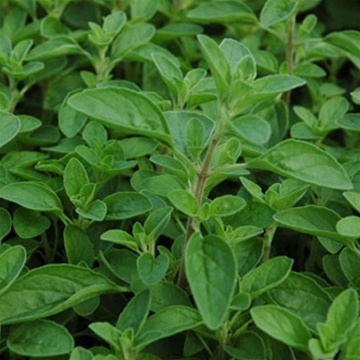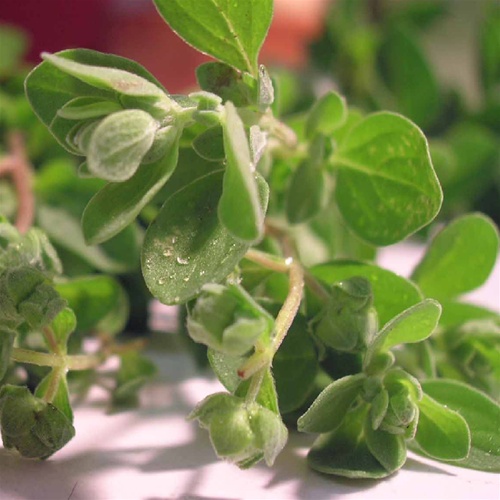by Kenan White | Sep 16, 2013 | Gardening, Herbs, Seeds |

I am a Road Warrior! Before your mental image focuses, let me qualify that with the word “gardening”. So, what I really am is a Gardening Road Warrior. Let me explain that I am not zipping down the road at blinding speeds. No I am the one standing in the roadside weeds while cars and trucks of all kinds hurdle past me in their rush to get somewhere. The warrior part comes from the fact that one must be somewhat brave to be out here on the side of the highway. Safety aside, it looks, and feels a little weird too.
If not a warrior, then maybe I can be a hunter and gatherer? That is exactly what I am doing! I am out here on the side of the highway hunting for dried wildflowers so that I may gather their seeds. I have always been a traditional type of gardener, and feel this activity really reaches back to the roots of gardening. Having something I want as bad as the seeds I am hunting, gives the activity real meaning. When harvesting seeds, I am so intent upon my mission that I often forget it takes place on the roadside. Seeds are more about what they are going to be than just the seeds themselves.
Collecting wildflowers seeds, I image what would happen if I sowed them all this way or that. Creating visions of color that change with the season. A meadow in bloom or the Spring Prairie, with enough seed and a little land anything is possible. The small bags of seed I collect can plant acres of land, how such a small amount can create so much is one of the great mysteries we will never unfold. But as long as we know how, we need never know why seeds do as they do. All we need know are the few small requirements each seed needs to release their magic in the world. Is there anything else that says, “Just add water,” and will grow the Garden of Eden?
Yes, seeds are magic. And I can share in that magic. When possibilities are boundless, I can be a Road Warrior, or a hunter-gatherer, or prompt into reality a beautiful vision, or anything I want to be. As long as I do it in the garden, where just about anything is possible.
by Kenan White | Sep 6, 2013 | Seeds |

Saving Seeds for the Future
Many herb gardeners prevent their plants from producing seeds by removing flowers. It is well known that doing this will increase the potency of herbs harvested at The Growers Exchange. We see this all the time, as we allow all of our garden herbs to go to seed. When the plants begin to make seeds, they do not put much effort into anything else, such as growing new foliage. Plants usually end their season looking pretty haggard. They are worn out; existing foliage is by now old and has suffered the ravages of weather and summer sun. But standing proud and dried above it is the product of its efforts; a bunch of seeds ready, willing and able to make a whole lot of new plants. There is value and intrigue in that seed head.
To begin, let me explain that I am a seed collector, I am the one seen by the roadside, bucket in hand thrashing through the weeds. And yes, people do sometimes stop and ask if I need help? Am I lost? Or confused? And of course I have been asked for ID by sheriffs, deputies, police, and state troopers. But, they all leave me as they found me in the weeds, shaking their heads and muttering about how “it takes all kinds”.
Learning to Collect Seeds
But they don’t know what I know! There is treasure is those weeds! Every gardener knows that seeds are expensive. With a little planning, seeds fresher than any you can buy are there for the taking. I divide my collecting into wild seeds and garden seeds. All the roadside adventure happens while collecting wild seeds, but I want to explain how I collect herb seeds from my garden.
As a commercial grower of herb plants, our biggest unknown is obtaining viable herb seed. Seeds are alive even though they don’t look it. They lose viability with age; this is a process some of us gardeners are familiar with. To hedge, we harvest seeds as well as buy them, hoping for good germination, but having to wait weeks to know. Seeds freshly collected usually germinate near 100%, they are worth the effort of collecting and cleaning. The nursery office is surrounded by our Growers Exchange herb garden, where we grow all the herb plants we sell. Our garden is invaluable to the greenhouse, often providing seeds or seedlings when not available anywhere. The herb garden also allows us to be familiar with the plants through their lifecycle. We can be of more help to customers when we are growing herb in a garden just like them. Many customers’ questions have been answered by someone first going outside to see what our plants are doing.
Collecting Herb Seeds
Collecting seeds is easy! All you need is a bucket and a willingness to grab hold of bunches of dried plant. The most important thing is understanding the nature of the seed being collected. Once the seed head is dried, each has unique characteristics just like the flowers they once were. Look at the seed head and determine how they are going to fall when you begin. Some pods are like little pitchers, waiting to pour their contents; others, the seeds are the head and they must be removed from a center cone. The nature of the problem is mechanical, not horticultural. In other words, common sense will lead you to a successful harvest.
Fall is here and now is the perfect time to start seed collecting! Seed collecting saves money, and is the most economical way to reap new plants for your garden year after year. Many gardeners also enjoy sharing their favorite seeds with friends. Don’t be afraid to get your hands dirty when collecting herb seeds – you’re bound to be rewarded with surprises.
When to Collect Herb Seeds
The method I use, to collect seeds, is to set the bucket on the ground and bend the seed heads over the bucket. It is important that the heads be over the bucket when tipped, as the seeds may just fall out. Some seed heads need to be crushed and some rolled between your hands. Just do it over the bucket so it all falls in. Annuals are some of the best and most pervasive plants to produce from home-saved seed, but bulbs, perennials and even some shrubs and trees can be equally gratifying. Be prepared for some variation in seedlings, especially if collecting from F1 hybrids which are special varieties bred by the seed companies for consistency and robustness; the seedlings produced by these plants are not likely to have the same properties as the parent plant. However, the different characteristics may be good ones and it makes the whole process more exhilarating!
It’s not always obvious when seeds are ready. The correct time to collect seeds from their fruits may differ from the time they are ready to eat. Some seeds are very straightforward and basically require storing until they’re ready for sowing, either into pots under cover or directly outside. Others, however, may be a little tricky and require preparation before they’ll germinate, such as exposure to certain temperatures, soaking, or breaking the seed coat. Seed pods and seed heads will usually dry out when they’re ready for collection, becoming straw-pale and papery. If you want to hold on to a few of these plants to produce seeds for next year you’ll actively want them to ‘bolt’, or run to seed. Of course, a lot of seed collection is commonsense. Just think about what would happen in nature when seeds are ripe and aim to copy that.

How to Collect Herb Seeds
- Choose a dry, windless day. Select a healthy, pest- and disease-free plant, whose seedpods appear as if they are about to split. Remove the entire seed head.
- Invert the entire seed head upside-down into a paper bag. Close bag without crushing the seed head and label. Place bag in a dry place for the seeds to ripen.
- Check the seeds’ progress regularly. When most of the seedpods have opened, remove the contents onto a dry surface and separate seeds from any bits of seed head still attached.
- Extracted seeds will need to be properly cleaned before storing to remove any remaining debris. Dried seeds can be sorted from its chaff by shaking the whole lot through a series of graded sieves/screens. Stack the sieves with the largest mesh size on top and smallest at the bottom, tip the seeds in and shake. One of the sieves will be just the right size to collect the majority of the seeds, leaving the chaff behind in the remaining sieves.
- Store the cleaned seed in a small dry envelope, seal and label carefully. Keep in a cool, dry, airy place until ready to be used. If kept in an air-tight container and placed in the refrigerator, these seeds will be good for at least six years.

Cleaning Herb Seeds
Cleaning seeds is not too difficult. If a seed sieve is not available, raid the kitchen for one and grab the colander too. The large trash can be removed from the bucket by hand; leaves, stems, etc. The mess at the bottom is a mix of powdered dried plant and the seeds. Use various size screens to separate the two. In one of your screens you will find clean seed, the treasure you seek! These seeds should be stored in paper envelopes inside where temperature and humidity are controlled. Never, ever, ever store them in plastic or the refrigerator; one rots them the other dies them out.




You will have way more seeds than you will need. So, you should indulge in the gardener’s practice of sharing the bounty with fellow gardeners. Giving away flowers and veggies is great. But when you stop to consider the gift of seeds, you realize it is a gift of possibilities. And even though it has been said many times, when messing with seeds, think about what the Navaho say. The simple statement that creates endless possibilities: “See This Seed, It is Not a Simple Thing”. Think about what a seed looks like and what it is capable of and you will see that messing with seeds is messing with one of the great mysteries of life. Is there any wonder as to why we garden?

by Kenan White | Jul 26, 2013 | Recipes |
After working, taking care of kids, and running errands, the last thing almost anyone wants to do is figure out what is for dinner. Instead of spending more money on unhealthy food, have a few easy and healthy go-to weekday dinner plans. Cooking does not have to be difficult, and summer is just around the corner. It is time for farmers markets, fresh tomatoes, and basil in your garden. Enjoy your summer dinners by using fresh herbs such as basil to make your meals easy, tasty, and nutritious. Instead of having to hit the store every day, get fresh herbs straight from your garden. Below are three easy and healthy basil recipes.
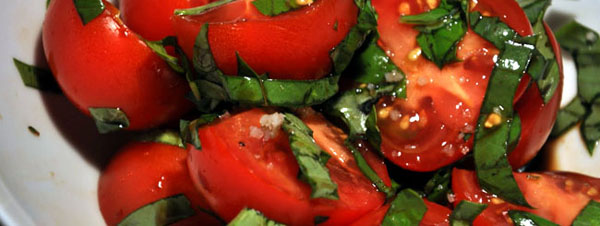
1. Simple and Delicious Tomato and Basil Salad
Cooking does not get much easier than this. Note that it is important to use ripe tomatoes that are in season. The recipe can easily be adjusted to serve between two and several dozen people.
6 small servings of salad
Ingredients:
- Several ripe heirloom tomatoes
- Several basil leaves, coarsely torn
- Olive oil
- Balsamic Vinegar
- Salt
- Pepper
Shortly before serving, slice the tomatoes and arrange them on a plate facing up. Lightly drizzle the olive oil and balsamic vinegar on the tomatoes. Top the tomatoes with the basil. Season with salt and pepper to taste.
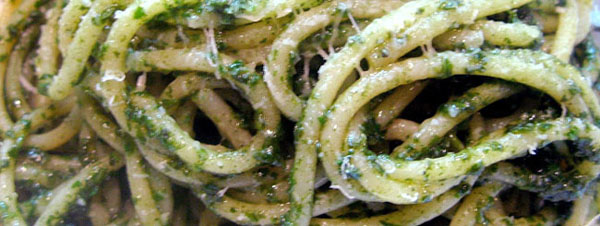
2. Easy Pesto Sauce
Pesto sauce is a way to make spring and summer pasta dishes more festive. When stored in airtight containers, this sauce will last about 6 months in the freezer. Freezing sauce in individual containers is highly recommended as the sauce takes time to make and is better when made in larger quantities.
8 cups of sauce
Ingredients:
- 2 cups fresh basil
- 4 garlic cloves
- 1 cup pine nuts
- ¾ cup olive oil
- ½ cup pecorino cheese, grated
- 2 ½ cups parmesan, grated
- Salt
Boil basil leaves for 5 seconds or until wilted, drain, squeeze out excess liquid, and set aside. Blanche the garlic. Coarsely chop the basil. Place the basil, garlic, pine nuts, and olive oil in a large bowl. Use a hand mixer to blend into a coarse sauce. Stir in the cheeses, and season with salt to taste. Put extra sauce in small airtight containers for later use.
The easiest way to turn pesto sauce into a complete meal is to make quick pasta. By having extra sauces on hand, dinners can be as easy as boiling pasta water and reheating the sauce in a microwave or on the stovetop. Homemade sauces are quick and easy in addition to being cost-effective.
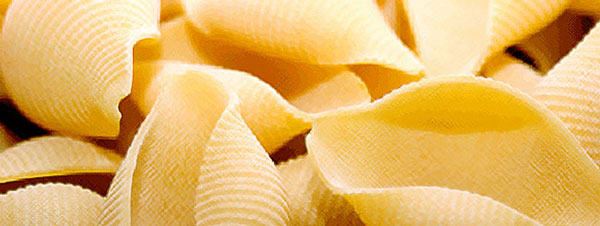
3. Shell Pasta With Creamy Basil Sauce
This recipe tastes very similar to a traditional Alfredo Sauce. By using yogurt instead of heavy cream, this pasta is healthier without sacrificing taste. The fresh basil and feta give this dish more interesting and subtle flavors along with a great, creamy texture. Eliminating the chili flakes can make this dish more kid-friendly. For people that like more of a kick, extra hot Syrian or Turkish chili flakes can make the dish even better.
Serves 4
Ingredients:
- 2 cups plain Greek yogurt
- 2/3 cups olive oil + a few tbsp. extra
- 1 lb. bag frozen peas
- 1 lb. pasta
- 1/3 cup pine nuts
- 2 tsp. chili flakes (adjust to taste)
- 1 2/3 cups coarsely torn basil leaves
- ½ cup feta cheese
- Salt and pepper
Place the Greek yogurt, olive oil, and ¼ cup of the peas into a food processor. Blend into a uniform sauce and transfer to a large mixing bowl. Cook the pasta according to the directions until al dente. Fry the chili flakes, pine nuts, and some of the peas in olive oil for about 4 minutes. Drain the pasta and shake well. Add the pasta gradually to the yogurt sauce while stirring constantly to avoid curdling. Note: adding the pasta all at once might cause the yogurt sauce to split. Immediately before serving, add the basil, and feta. Season with salt and pepper to taste. As a last step, pour the pine nuts and oil mixture over the top of the dish.
Have a better life by eating better food
One of the best ways to make healthy food taste better is to put in a little extra effort and add herbs such as basil instead of preservatives. Take advantage of summer produce that is readily available. Who knows? You might fool the guests at your next dinner party or potluck into thinking that you went to culinary school by understanding flavor profiles and cooking easy, delicious food with fresh herbs from your garden.
by Kenan White | Jul 10, 2013 | Herbs, Recipes |
What Is Marjoram And How Can I Use It?
Whether you are a veteran chef or you are just learning how to cook, you are sure to benefit greatly by adding herbs to your list of favorite cooking ingredients. Foods that are cooked with herbs simply taste better. When first starting out on your culinary journey, it can be intimidating to look at the vast array of herbs available at the grocery store or farmer’s market and know what to do with them. It is best to do some research on different types of herbs and sure fire food combinations to use with them that have been tried and tested.
Some herbs are more common than others. For example, you may have heard of the herb thyme, but perhaps you have never heard of the herb marjoram. If you have a pre-packaged herb and spice rack in your kitchen with a little bottle labeled “marjoram”, you may have asked yourself the question, “What is marjoram and how can I use it?” Of course we always prefer fresh herbs, and you can purchase marjoram plants online directly from our store.
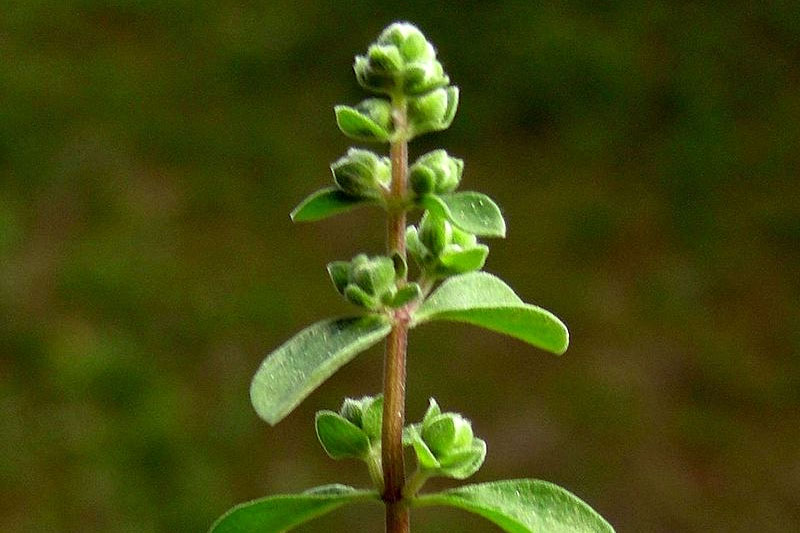
Marjoram plant with flower buds
What Is Marjoram Exactly?
Marjoram is an herb in the mint family that is commonly mistaken for oregano, although it has a milder flavor. Many say that it has a slight taste of citrus and sweet pine. It grows wild in Mediterranean countries such as Cyprus, Turkey, and Greece, and is a popular additive to their sauces, soups, and meat dishes. Because marjoram is a perennial, it can live for several years. However, it typically does not survive cold temperatures. If you decide to grow marjoram on your own, you may need to replant it in a pot during the colder months, depending on where you live. This herb prefers full exposure to the sun and is best planted in well-drained soil where it has room to spread.
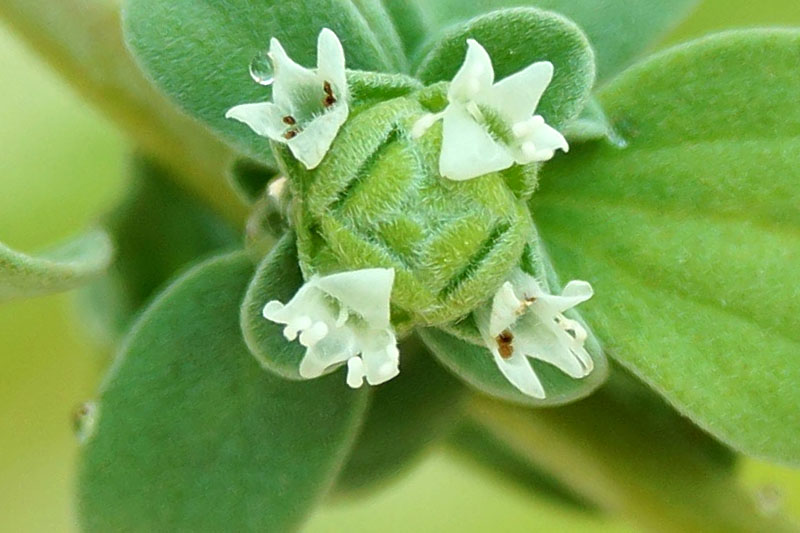
How Can I Use Marjoram?
The herb marjoram is often used in body care products such as soaps, lotions, and shaving gel. It is sometimes made into an essential oil used in aromatherapy treatments because of its apparent ability to sooth one to sleep and reduce stress. Some other proposed benefits of Marjoram include its ability to relieve flatulence, nausea, cramps, and swelling.
Aside from marjoram’s health and beauty uses, it also has many culinary uses. Both fresh and dried leaves can be used to season foods with its mild, bittersweet taste. It is often included in the popular English dish of roast goose with chestnut stuffing and in German cooking as a part of a spice mixture added to sausage. In most recipes, you will see marjoram called for in combination with other herbs and spices such as oregano, basil, and parsley.
Recipes That Call For Marjoram
Try the following recipes or experiment with some of your own in order to get a taste of marjoram.
Black-eyed Peas and Leeks
Recipe from Miriam Bale
- 4 leeks, dark green parts trimmed, quartered lengthwise, sliced in ½ inch segments
- 3 cups cooked black-eyed peas
- ¼ – ½ teaspoon dried marjoram
- 1 teaspoon dried tarragon
- 1 tablespoon olive oil
- 3-4 tablespoons butter
- salt to taste
The night before, cover black-eyed peas with water and soak them for at least four hours. Drain, place in a large pot, and cover with about 3 inches of water. Simmer until the peas are cooked through, salting generously in the last ten minutes of cooking. While the peas are cooking, heat the olive oil over medium heat with 1 tablespoon of the butter in a large pan. When hot, add some salt and stir in the leeks. Cook gently, stirring frequently until the leeks appear golden. Add the peas to the skillet. Cook until heated through, and then stir in the marjoram, tarragon, some salt, and the remaining 2-3 tablespoons of butter.
Grilled Fish with Orange and Marjoram
Recipe from Eric Werner
- 2 1 1/4-pound gray snapper, whole porgy, or branzino, cleaned
- 8 sprigs fresh marjoram + 1 tablespoon marjoram leaves (dried marjoram can be used)
- 2 small oranges or tangerines, peeled, seeded, and separated into segments
- 2 tablespoons olive oil
- salt and pepper to taste
Prepare a charcoal grill or a gas grill to medium-high. Make 3 diagonal slices spaced about 1 1/2″ apart on each side of fish. Season fish with salt and pepper to taste. Stuff each fish with 4 herb sprigs and segments from 1/2 orange. Rub each fish with 1 tablespoon oil. Grill fish for 3-4 minutes, or until skin no longer sticks. Carefully turn fish and grill until cooked through, about 3-4 more minutes. Transfer to platters and garnish with remaining marjoram leaves and orange segments.
Using marjoram in health and beauty care or in cooking is a great way to explore this less-often used herb. As you try out other uses for marjoram in recipes and in everyday life, you are sure to be delighted by its unique aromatic properties.
by Kenan White | Apr 17, 2013 | Containers |
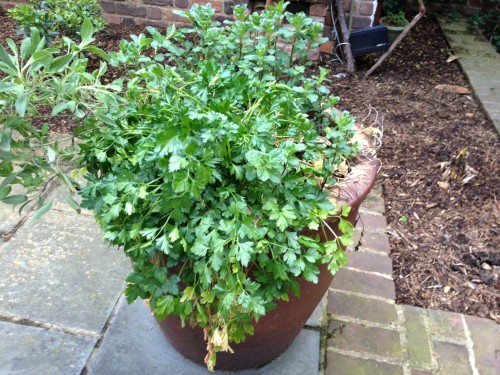
I’d like to take this opportunity, as many people throughout the country still await warmer weather before they can really start digging into the earth, to discuss my experience with container grown herbs . . .up close and personal.
It’s is so easy to plant a potted herb garden that many actually prefer to do so, instead of trying to find space amongst the vegetables. Plus, this makes it easier to place the garden right outside the kitchen, which also makes the home cook happy.
In order to make your own potted herb garden, use pots that are at least six inches in circumference, potting soil, compost, and a trowel. While some like to do smaller, individual pots, I like a larger potted garden, where plants can mingle. I recommend a large container. Mine is almost thirty inches in diameter, three-and-a-half feet tall, and sits tight against the house where it is well insulated.
Once you plant the first crop, it will be easier to maintain. I have had one outside for the past 3 years, and I only need to fill in a few plants each year. In my area, we are considered Zone 7. Herbs such as Garden Sage, Italian Parsley, Kitchen Citrus Mint, and Marjoram do very well in this zone and will all survive year after year, if properly cared for. However, there are always those I have to replace each spring. For instance, I need to replace my basil almost every year, and my thyme died this past winter.
As with any garden, there are a few persistent plants that will be more aggressive when fighting for space in the pot. You will have to be brutal with the mint, as it will take over the space if you let it. However, these hardier herbs are also survivors, and I am using parsley almost all year… and, of course, the mint. That’s not such a bad thing as I have discovered the value of minted water (I have a Brita and just keep a sprig or 2 in the bottom to flavor the water).
With your own potted herb garden, similar inspirations will only be a few steps away!















